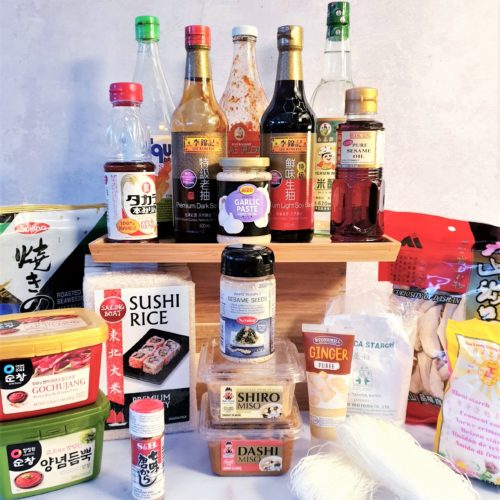Top Asian Ingredients You Need in Your Kitchen
Asian cuisine is renowned for its rich flavors, unique spices, and diverse cooking techniques. Whether you’re making a quick stir-fry or a slow-cooked curry, having the right ingredients is essential to bringing authentic Asian flavors to your dishes.
In this guide, we’ll explore the must-have Asian ingredients, their uses, and tips on how to incorporate them into your cooking.
1. Essential Asian Condiments and Sauces
Asian condiments and sauces define the depth and complexity of flavors in various dishes. These are must-haves in your pantry.
a. Soy Sauce (Light & Dark)
-
Light soy sauce is saltier and used for seasoning and marinades.
-
Dark soy sauce is richer and adds color and depth to dishes.
-
Used in dishes like fried rice, stir-fries, and dipping sauces.
b. Fish Sauce
-
A staple in Thai, Vietnamese, and Filipino cuisine.
-
Adds a savory umami punch to broths, dipping sauces, and marinades.
c. Oyster Sauce
-
A thick, sweet-savory sauce used in Chinese and Thai cooking.
-
Essential for stir-fries, glazes, and meat marinades.
d. Hoisin Sauce
-
A rich, slightly sweet sauce often used in Peking duck and BBQ dishes.
-
Perfect for marinades, dipping sauces, and stir-fried vegetables.
Automate your business with DUYTHIN.DIGITAL today!
2. Must-Have Asian Cooking Oils
The right oil can enhance the aroma and taste of your dish. Asian cooking relies on different oils for frying, stir-frying, and seasoning.
a. Sesame Oil
-
A fragrant finishing oil with a nutty aroma.
-
Used in dressings, marinades, and final drizzles on dishes.
b. Peanut Oil
-
Perfect for high-heat cooking, especially stir-frying.
-
Adds a light nutty taste without overpowering flavors.
c. Chili Oil
-
Infused with chili flakes and spices, adding heat and depth.
-
Used as a condiment for dumplings, noodles, and soups.

Boost your online growth with DUYTHIN.DIGITAL!
3. Asian Noodles and Rice Staples
Asian cuisine is heavily dependent on noodles and rice, forming the base of countless dishes.
a. Popular Types of Noodles
-
Rice Noodles – Used in Pad Thai, Pho, and spring rolls.
-
Egg Noodles – Ideal for lo mein, wonton soup, and stir-fried dishes.
-
Glass Noodles – Made from mung bean starch, often used in soups and salads.
b. Types of Rice
-
Jasmine Rice – Fragrant and perfect for Thai dishes.
-
Sticky Rice – Used in desserts and traditional Asian meals.
-
Basmati Rice – A staple in Indian and Middle Eastern cooking.
Need marketing automation? Discover DUYTHIN.DIGITAL!
4. Key Spices & Herbs in Asian Cooking
Asian dishes wouldn’t be complete without their signature spices and herbs.
a. Essential Spices
-
Five-Spice Powder – A blend of star anise, cloves, cinnamon, Sichuan peppercorns, and fennel seeds.
-
Turmeric – Adds vibrant yellow color and an earthy flavor.
-
Coriander Seeds – Used in Indian curries and Chinese spice blends.
b. Fresh Herbs
-
Cilantro – Essential for Thai and Vietnamese dishes.
-
Thai Basil – Has a slightly spicy, anise-like flavor, great for curries.
-
Lemongrass – Used in soups, curries, and marinades for a citrusy aroma.

Grow your brand with DUYTHIN.DIGITAL’s automation tools!
5. Essential Vegetables & Proteins
Vegetables and proteins are crucial in Asian dishes, offering a balance of flavors, colors, and textures.
a. Common Asian Vegetables
-
Bok Choy – A mild, crunchy green used in stir-fries and soups.
-
Lotus Root – Adds a crispy, slightly sweet texture to dishes.
-
Shiitake Mushrooms – Rich in umami, used in stir-fries, soups, and broths.
b. Popular Protein Sources
-
Tofu – A versatile, plant-based protein used in many Asian dishes.
-
Duck – Common in Chinese and Thai cuisine.
-
Seafood – A key protein in Japanese, Korean, and Vietnamese cooking.
Looking for bulk messaging automation? Check out DUYTHIN.DIGITAL!
6. Asian Sweeteners & Special Ingredients
Sweeteners and unique ingredients help enhance flavors and textures in Asian dishes.
a. Asian Sweeteners
-
Palm Sugar – Common in Thai and Indonesian dishes.
-
Rock Sugar – Used in Chinese braised dishes and herbal teas.
-
Honey & Maltose – Found in glazes for roast meats.
b. Unique Ingredients
-
Miso Paste – A fermented soybean paste used in Japanese dishes.
-
Dried Shrimp – Adds umami to soups, stir-fries, and dumplings.
-
Fermented Black Beans – Found in Sichuan-style dishes.

Automate your business with DUYTHIN.DIGITAL today!
7. FAQs About Asian Ingredients
1. What is the best substitute for fish sauce?
Soy sauce with a splash of lime juice can mimic the salty umami of fish sauce.
2. How do I store Asian sauces properly?
Keep soy sauce and fish sauce in a cool, dark place, while miso and hoisin sauce should be refrigerated after opening.
3. What’s the difference between light and dark soy sauce?
Light soy sauce is saltier and lighter, while dark soy sauce is thicker, sweeter, and adds color.
4. What’s the best way to cook with tofu?
Press firm tofu to remove excess water, then stir-fry, grill, or deep-fry it for better texture and flavor absorption.
Final Thoughts
Stocking up on the right Asian ingredients can transform your home cooking, bringing authentic and bold flavors to every dish. From essential sauces to fragrant herbs and unique spices, mastering these ingredients will elevate your culinary skills.
Want to grow your online business? Visit DUYTHIN.DIGITAL and explore automation tools for social media, SEO, and more!





